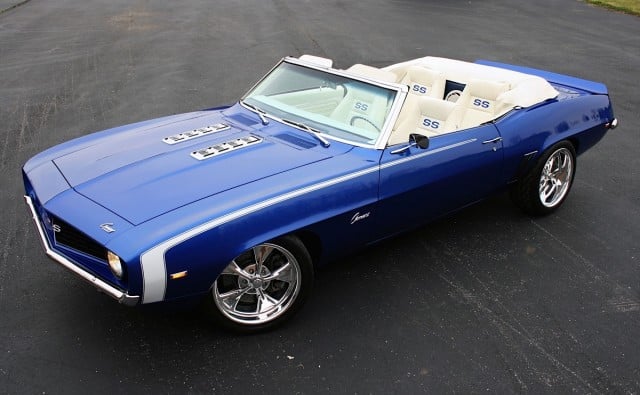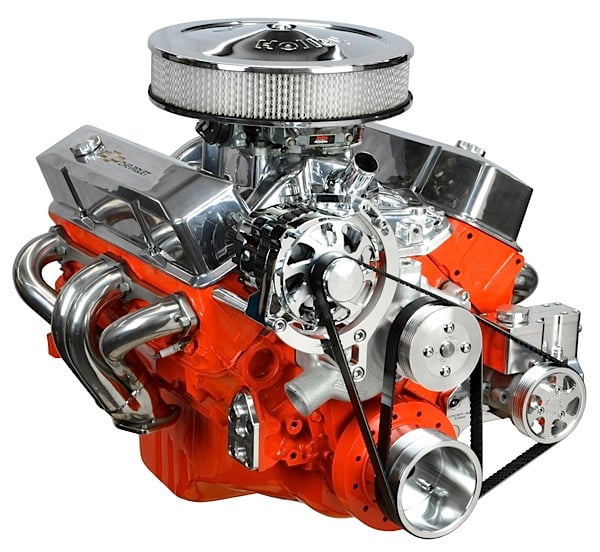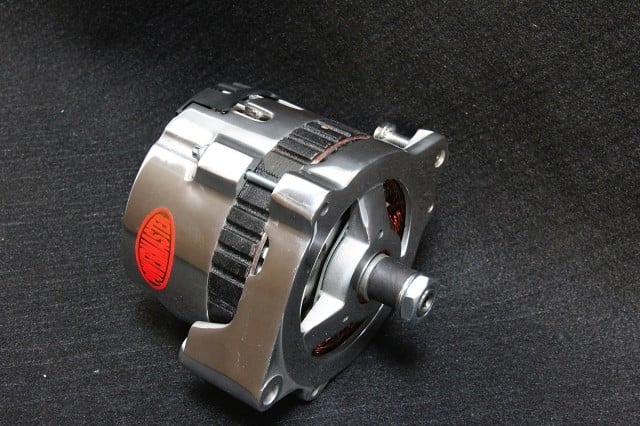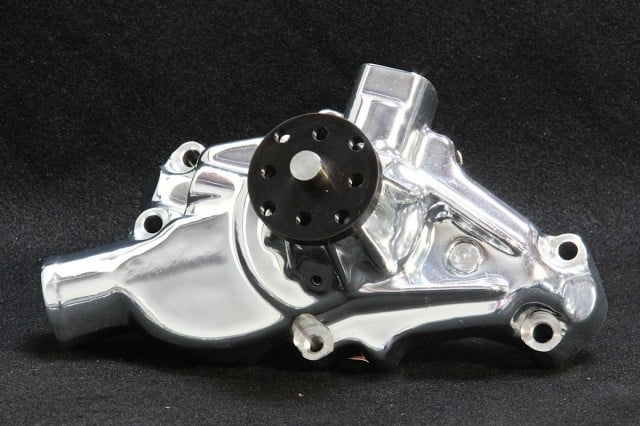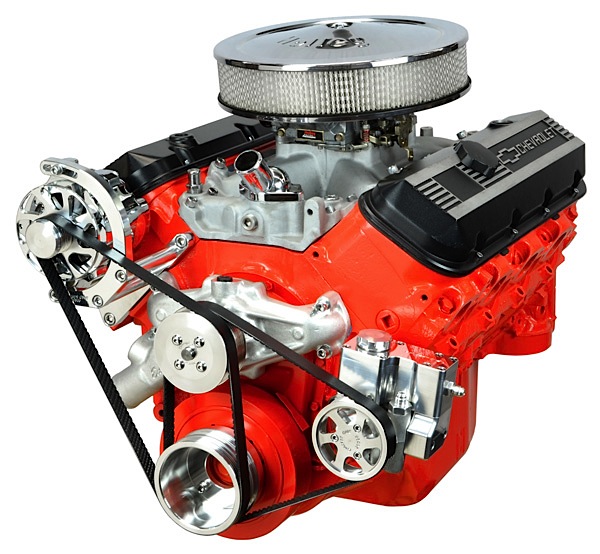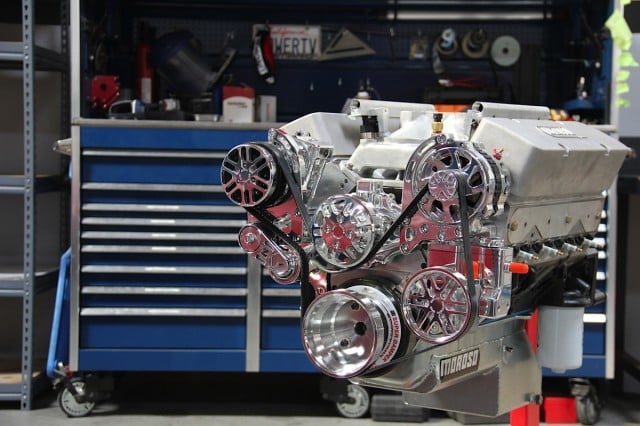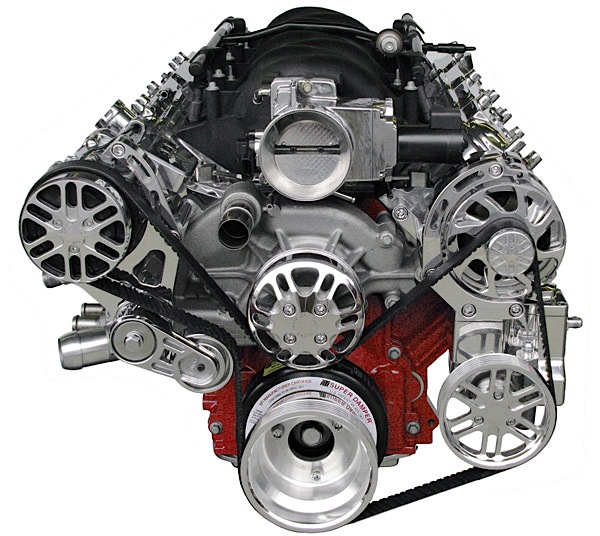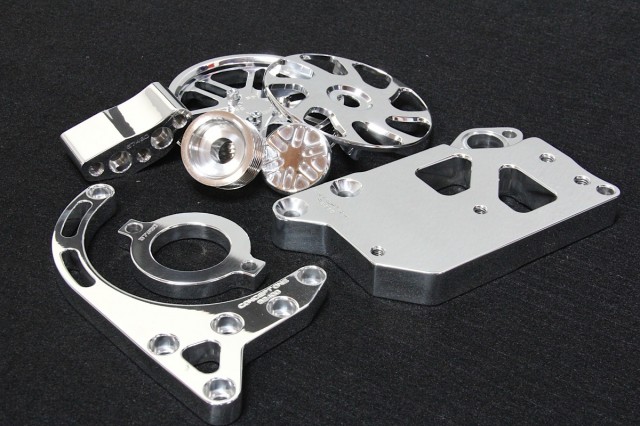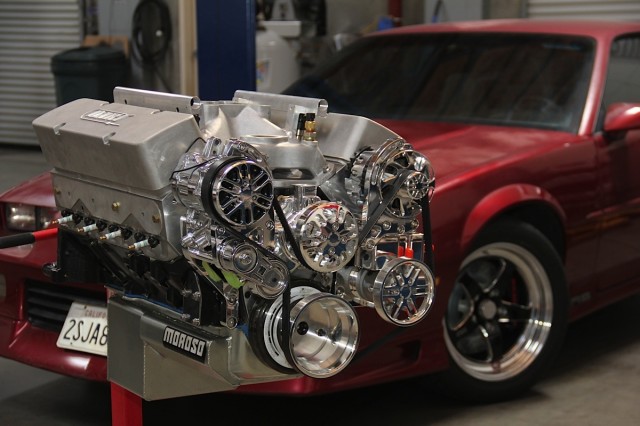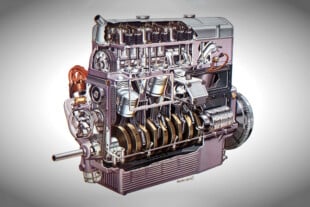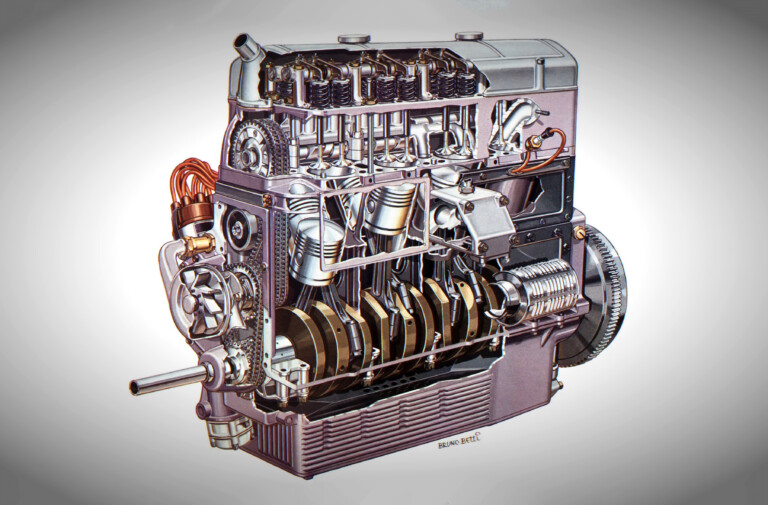Unless you’re restoring your vintage Chevy to factory specifications, it makes little sense to bolt on the archaic V-belt accessory drive system. Converting to a contemporary serpentine-belt drive offers a number of advantages, including strength, durability and the virtual elimination of “throwing” – or losing – a belt.
Lower heat generation is another big reason to consider swapping V-belts for a serpentine system. It’s one of the big reasons the serpentine-type system was developed in the first place, because the thinner serpentine belt doesn’t retain heat like a thicker V-belt. And the serpentine belt’s strength and longevity are tied to its long design, which has the properties of a long strand that is much harder to break.
As for that phenomenon of throwing belts, the “wrap” of the serpentine belt is much tighter than a V-belt-driven accessory. This greater tension reduces belt slippage, which not only prevents it from slipping off, but increases the overall life of the belt. It can also mean more horsepower and greater fuel efficiency, because less slippage translates into a lower load on the engine – and the less work the engine has to do, the more power it makes with less fuel.
Enter Concept One and their unique line of high-performance serpentine systems which range across all platforms and applications. Serpentine systems employ a tensioner, which keeps the optimal tension on the belt at all times and all engine speeds. It also helps dampen vibrations generated by the various engine-driven accessories. Without a doubt, the advantages of a serpentine system are clear, but converting from a conventional V-belt accessory drive is a little more involved, yet it’s still a bolt-on project that any enthusiast with moderate mechanical experience can handle at home.
For small- and big-block engines that originally came with V-belts, you’re going to need to swap out the water pump, along with the accessory-drive pulleys. That’s because the water pumps used with GM serpentine systems turn the opposite way of early-style water pumps. Most kits include the correct water pump. And if you’ve got more or higher-load electrical equipment on board, such as a couple of electric fans, a high-power stereo, etc., you’ll want a high-amp alternator to be part of the system.
You could spend countless hours trying to scrounge a salvage yard for serpentine systems, but the quality of the used accessories is a gamble and you’ll likely have to replace some of the incomplete or missing parts. Conversion kits are plentiful and generally include new accessories, including the all-important water pump.
Indeed, going with a new system is the smart move and knowing that most enthusiasts, like us, are building their vehicle on a budget, we’ve focused this story on the entry-level range of serpentine systems for Chevy’s three engine families: small-block, big-block and LS. And to ensure we’re comparing apples to apples – or at least fruit from the same orchard – we’ve turned to Cumming, Georgia-based Concept One to gauge their range of serpentine conversion kits for the Chevy market.
Small-block kits: $795-$1,245
Concept One offers Basic, Contender, and Victory lineups of serpentine systems and for the aforementioned budgetary reasons, we’ll focus on the Basic kits. There are two of them: one that comes with only an alternator ($795) and another that includes an alternator and power steering pump/accessories ($1,245). Both kits have been recently revised to include more standard features, including:
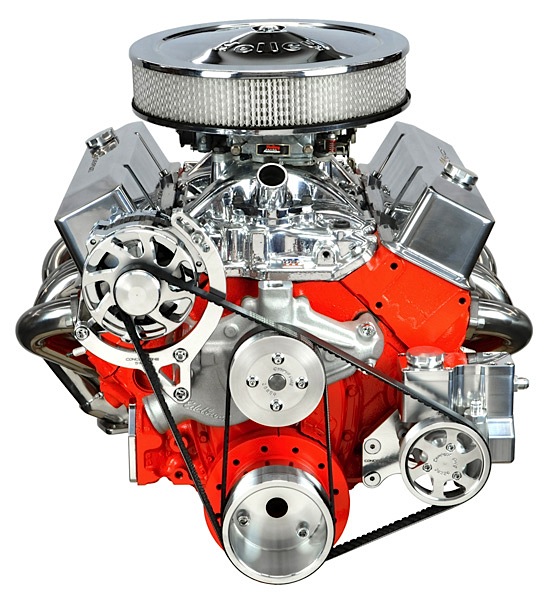 Edelbrock water pump
Edelbrock water pump- 105-amp polished Powermaster one-wire alternator
- Crankshaft pulley
- Water pump pulley
- Alternator pulley and bracket set
- Alternator fan and pulley cover
- Goodyear Gatorback belts
- Chrome hardware
The kit with power steering also includes a Delphi aluminum power steering pump that features a fluid reservoir. And because there are a variety of power steering configurations and applications, Concept One offers a number of no-cost and extra-cost specifications and/or upgrades:
- Pressure valve set to 1,300-1,400 psi for all GM racks and gears is standard
- Pressure valve set to 800-900 psi for the Mustang II rack or 1,100-1,200 psi for the T-bird rack and Ford gears costs an extra $30
- The pump flow rate is tailored to 1.60 gpm (standard), 1.85 gpm (for the TCI rack) or 2.11 gpm for Hydroboost systems
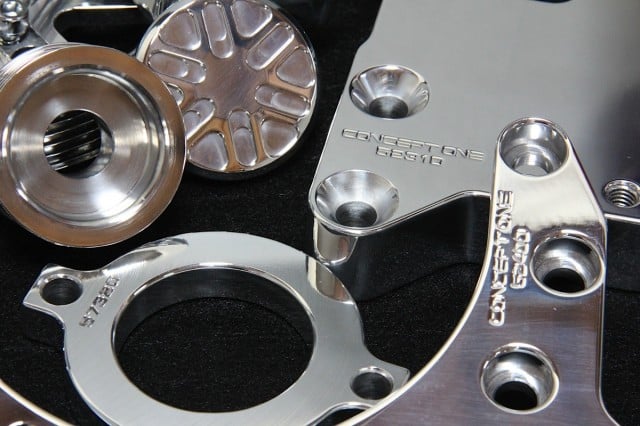
Concept One prides themselves on detail and quality – and as you can see, they definitely aren’t falling short on either!
The standard reservoir is a custom billet aluminum mini reservoir mounted on the pump; a remote reservoir can be substituted for it, along with a remote reservoir for Hydroboost systems. The Basic kits can be used with electric or standard mechanical cooling fans, but air conditioning compressors are not compatible with them. Those who want AC will have to step up to the company’s Victory kits.
Only the most trusted components are used to build each complete kit.
When it comes to bolting up the kits’ brackets, cylinder heads with accessory bolt holes are required, although Concept One offers an extra-cost kit for heads without the holes – or you can step up to the Victory level, which doesn’t bolt to the heads at all. Additionally, most small-block engines have drilled and tapped holes on either side of the harmonic damper, but some don’t. Concept One’s kits are designed to be used with those holes. This also means side motor mounts are a must – no front mounts.
A machined aluminum finish is standard on the Basic kits, although polished, anodized clear and anodized black finishes are all $150 options, with a bright “Endurashine” finish on the water pump offered as a $75 upgrade.
Big-block kits: $845-$1,295
Like their small-block kits, Concept One’s big-block Basic systems are offered only with only an alternator ($845) and with an alternator and power steering pump/accessories ($1,295). And also like the small-blocks system, both kits have been recently revised to include more standard features, including:
- Edelbrock water pump
- 105-amp polished Powermaster one-wire alternator
- Crankshaft pulley
- Water pump pulley
- Alternator pulley and bracket set
- Alternator fan and pulley cover
- Goodyear Gatorback belts
- Chrome hardware
Again, as with the small-block kits, the big-block system with power steering includes a Delphi aluminum power steering pump and a fluid reservoir. The same configurations and settings offered with the small-block kits apply, too:
- Pressure valve set to 1,300-1,400 psi for all GM racks and gears is standard
- Pressure valve set to 800-900 psi for the Mustang II rack or 1,100-1,200 psi for the T-bird rack and Ford gears costs an extra $30
- The pump flow rate is tailored to 1.60 gpm (standard), 1.85 gpm (for the TCI rack) or 2.11 gpm for Hydroboost systems
The standard reservoir is a custom billet aluminum mini reservoir mounted on the pump; a remote reservoir can be substituted for it, along with a remote reservoir for Hydroboost systems.
The Basic big-block kit with power steering is offered with a special bracket when it’s to be used with Corvettes to ensure adequate clearance near one of the control arms. And regardless of the vehicle, the Basic kits can be used with electric or standard mechanical cooling fans.
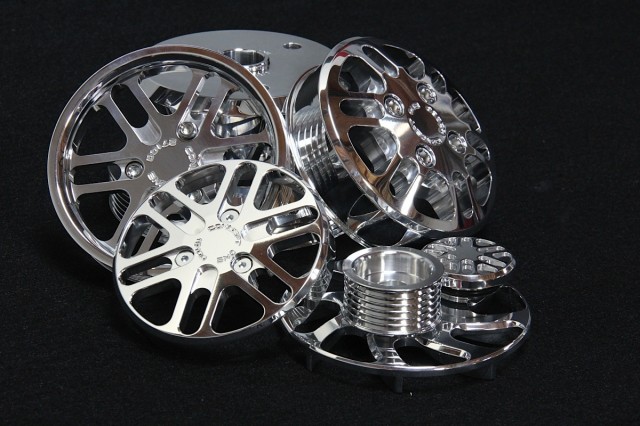 The most important consideration for installing one of the kits on a big block is the harmonic damper. It must have a recess for the pulley boss. The vast majority of Mark IV, Gen V and Gen VI big-blocks feature this, but some Gen VI engines don’t. GM part number 10216339 is the common, recessed damper for most applications.
The most important consideration for installing one of the kits on a big block is the harmonic damper. It must have a recess for the pulley boss. The vast majority of Mark IV, Gen V and Gen VI big-blocks feature this, but some Gen VI engines don’t. GM part number 10216339 is the common, recessed damper for most applications.
Concept One’s standard machined-aluminum finish is standard on the big-block Basic kits, with polished, anodized clear and anodized black finishes available for $150 – and the bright “Endurashine” finish on the water pump costs an extra $75, too.
LS-engine kits: $1,595-$2,345
The LS engine is a whole new animal in the hot rod world and is quickly becoming the swap engine of choice for more and more builders. Of course, these engines came from the factory with serpentine drive systems, but they’re not always compatible with the chassis of older vehicles and, frankly, they don’t have the eye appeal of Concept One’s machined-finish hardware.
There is no Basic level of systems for LS engines, only the Victory level, which starts at $1,595 for a kit driving only an alternator. Included in that base system, however, is:
- Cast aluminum water pump
- 105-amp polished Powermaster one-wire alternator
- High-performance SFI-approved harmonic damper
- Crank pulley, water pump pulley and alternator pulley
- Complete bracket set for the alternator
- Alternator fan and alternator pulley cover
- Goodyear Gatorback belt
- GM tensioner
- Chrome hardware
Stepping up, the next LS kit offers an alternator and power steering for $1,995. There’s also a kit with an alternator and air conditioning compressor (no power steering) for $1,995 and the whole shebang with the alternator, power steering and air conditioning compressor for $2,345.
There are also kits available that accommodate popular aftermarket superchargers, such as the Eaton-based Magnuson blowers and Edelbrock’s E-Force systems.
Importantly, Concept One’s kits are designed to work with all LS engines, whether you’ve got an LS7 from a Corvette Z06 or the stalwart 5.3-liter engine from a salvage-yard Silverado. They’re designed to work with engines using cable-driven throttle bodies or, of course, carburetor conversions. They’ll also work with engines with variable valve timing (LY6, L76 and L92, etc.), although that requires a unique part number – and an additional $200. The same goes for the LS7 engine, which has a slightly different crank pulley setup.
As with the small-block and big-block kits, the LS Victory kits feature a standard machined-aluminum finish, with polished, anodized clear and anodized black finishes available for $200. An upgrade to a 140-amp alternator is a $50 charge, too.
Basic installation tips and tricks:
Generally speaking the typical conversion takes up to an hour if the engine is in the vehicle. It goes a bit quicker if you’re working with the engine out of the car. Although most serpentine systems are generally universal for the type of engine – small-block, big block, etc. – installing one changes the dimensions of the front of the engine and that can have consequences under hood.
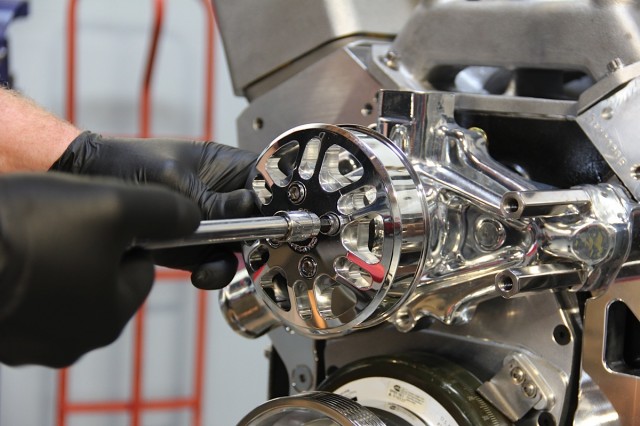 “For the most part, changing to a serpentine system won’t be a problem, but if you’re building a street rod or something else that doesn’t have a lot of extra room under the hood, you’ll need to be aware of the clearance between the radiator and electric fan assembly and the serpentine system,” says Concept One co-founder Kevin Redd.
“For the most part, changing to a serpentine system won’t be a problem, but if you’re building a street rod or something else that doesn’t have a lot of extra room under the hood, you’ll need to be aware of the clearance between the radiator and electric fan assembly and the serpentine system,” says Concept One co-founder Kevin Redd.
“If you’re putting a big-block in an old Chevy II or even a Tri-Five Chevy, the clearance can be tight – and it’s definitely easier on applications like that to do the serpentine conversion with the radiator out of the car.”
Redd also suggests that you always talking with a consultant from a serpentine system manufacturer to discuss the equipment on your car. Knowing that you’ll need a system with an air conditioning pump is obvious, but other factors come into play.
Changing to a serpentine system won’t be a problem, but if you’re building a street rod or something that doesn’t have a lot of extra room, you’ll need to be aware of the clearance between the radiator and electric fan assembly. -Kevin Redd
“If you’re running a rack-and-pinion steering system vs. an old steering gear, for example, can determine which power steering pump we include for your application,” he says. “And if you’re only running a single electric fan and no big stereo, you can probably get by with a 105-amp alternator instead of a 140-amp unit.”
At the top of the engine – especially on fuel-injected LS engines with a protruding throttle body or supercharger – belt clearance can be tight, as well. Again, careful measurements are the key to an interference-free installation. It’s necessary, because the stock serpentine drive system for most production LS engines places the alternator and air conditioning pump in low positions, which typically interfere with the front cross-member of many older vehicles – particularly A-bodies and early Camaros.
Concept One’s website offers detailed diagrams showing the installed dimensions of their serpentine systems. They are valuable references for planning your installation – and don’t forget the routing of coolant and other hoses in the engine compartment.
If your car doesn’t have more than one electric fan and a basic stereo system, you can probably get away with a 105-amp alternator, but if you’ve got a larger electrical load, make sure the serpentine kit you purchase comes with a 140-amp alternator.
“Don’t be intimidated by the conversion process,” says Redd. “If you’ve taken the proper measurements and have the clearance, the installation is a straightforward procedure that will make a world of difference in the performance and drivability of your classic Chevy.” All in all – these serpentine systems are a great option with very high-quality components that won’t break the bank.




